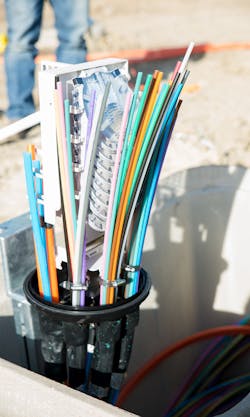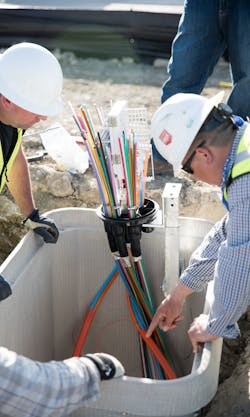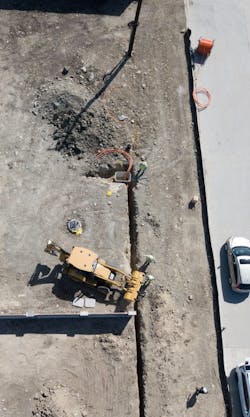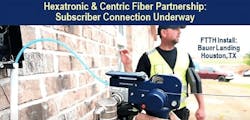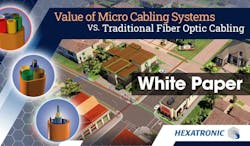Strategic FTTH Partners: Hexatronic and Centric Fiber
Hexatronic US, Inc., a wholly owned subsidiary of Hexatronic Group AB, has become a strategic partner with the communications provider Centric Fiber to supply complete end-to-end passive fiber optic systems for Centrics’ fiber-to-the-home (FTTH) build throughout the state of Texas. This partnership with Centric is an important milestone for Hexatronic as it serves to strengthen their position as a leader in fiber infrastructure FTTH installations within the U.S.
This video includes interviews with the key players in this partnership: Per-Anders Eriksson, CEO, Hexatronic US, and Jason Palmenberg, President/COO Centric Fiber.
COVID-19 has raised awareness for the importance of fast and reliable Internet to all residences. FTTH brings multi-gigabit Internet speeds and reliable connectivity into the home, similar to systems delivered to businesses, schools and other commercial buildings. With many people working from home and students engaged in distance learning, the connection to the Internet has often been disrupted due to the stress of concurrent video streaming, such as through Zoom conferences and gaming.
Fiber optic connectivity allows reliable Internet connection with no signal loss or interruption and on multiple devices (laptops, phones, tablets) simultaneously. In addition to speed and dependability, Centric Fiber systems enables home automation capabilities through the network. This allows the user to remotely manage and monitor household applications, such as lighting and security, if these are IP-based.
The video includes interviews with the key players in this partnership: Per-Anders Eriksson, CEO, Hexatronic US, and Jason Palmenberg, President/COO Centric Fiber. In addition, the video demonstrates an actual Texas on-site installation of the system which includes laying of the conduit and micro ducts and fiber pulling. Four different conduits are being installed to provide fiber to this particular residential district, each with 24 different micro duct tubes. Explaining these procedures are Beni Blell, Head of Sales, Hexatronic US, and Chris Williams, Director Site Technology, Hexatronic US. In addition to this installation, Hexatronic is also providing detailed training to the Centric Fiber staff and external contractors on system design and installation.
Centric Fiber, a leading service provider in Texas, delivers high-bandwidth fiber optic connectivity to many homes, as well as commercial buildings. Centric Fiber is an Internet service provider and communications infrastructure company focused on expanding fiber optic communications throughout the state of Texas. Its primary focus is bringing differentiated solutions to the fiber-to-the-home (FTTH) market. The company is headquartered in The Woodlands, Texas. www.centricfiber.com
Hexatronic (www.hexatronic.com) is the supplier for all passive fiber optic infrastructure components, which employs a complete air blown fiber system versus traditional fiber optic cabling. Using micro cabling systems for access networks better utilizes appropriated funding by reducing CapEx and OpEx, and at the same time significantly reducing the impact on the environment.
Blown fiber micro cabling technology is quickly becoming the preferred system solution for access networks based on bandwidth requirements, speed of deployment, network flexibility, future scalability, and of course, the lowest total cost of ownership. When compared to traditional fiber cabling, micro cabling systems provide a much higher return on investment (ROI) due to reduction in material costs, as well as the overall lower cost in labor capitalized by drastic reduction in installation time.
When compared to traditional cabling techniques such as cables pulled in or jetted into large (traditional) conduits, blown cabling systems utilize much smaller micro tubes or micro ducts to blow (or "jet") lightweight optical fiber bundles or micro cables through predefined pathways at speeds of up to 300 feet per minute (~100 m/min). These micro tubes are manufactured of tough but flexible materials and are sized to accommodate up to 432 fibers or more per micro tube within a micro duct which can be installed aboveground (aerially) or underground.
More on Broadband Installation from Hexatronic:
Video: Hexatronic and Centric Fiber: Subscriber Connection Underway
Actual on-site installation of the micro ducts and fiber system which includes the blowing speed of 100 mpm from individual homes to the fiber distribution housing and the termination of 96 fibers per FDH cabinet.
White Paper: Critical Collaboration: Combining Partnerships and Technology for Widespread Broadband
“Part 1: Designing a Blown Fiber System for Widespread Broadband in Rural Colorado.” The Southern UTE Indian Tribe, Bonfire and Hexatronic.
White Paper: Value of Micro Cabling System vs. Traditional Fiber Optic Cabling Systems for Access Networks
Blown fiber cabling techniques were specifically developed to provide the lowest Total Cost of Ownership (TCO) and the highest level of network futureproofing. Read about cost, deployment speed and system flexibility.

